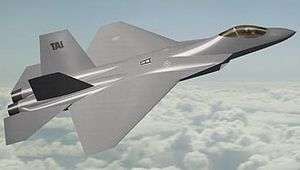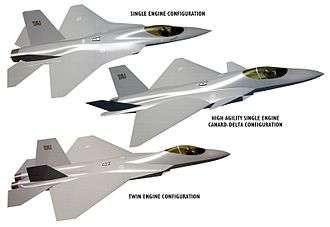TAI TFX
| TAI TFX | |
|---|---|
 | |
| One of the three concept designs | |
| Role | Air superiority fighter stealth[1] |
| National origin | Turkey |
| Manufacturer | Turkish Aerospace Industries |
| Design group | Turkish Aerospace Industries / BAE Systems |
| Introduction | 2025 (planned) |
| Status | Preliminary Detail Design Phase |
| Number built | 250+ (planned) |
| Program cost | US$25 billion |
| Unit cost |
US$100-110 million |
TAI TFX is a twin-engine[2] all-weather Fifth-generation Turkish aerial superiority fighter jet[3][4][5] being developed by Turkish Aerospace Industries (TAI) with technological assistance from BAE Systems of the United Kingdom. The aircraft is slated to replace the Turkish Air Force's F-16s and is being planned to be offered to foreign air forces as-well. The project is one of many ongoing high-profile military projects in Turkey.[6][7][8][9][10][11][12][13]

Development phase
On 15 December 2010, Turkey's Defence Industry Executive Committee (SSIK) decided to design, develop, and manufacture an indigenous next generation air-to-air combat fighter which would replace Turkey's F-16 fleet and work together with the F-35.[14] Funding equivalent to US$20 million was allocated for a 2-year conceptual design phase that will be performed by TAI.[15] TAI officials have stated that the conceptual design phase should be complete in late 2013, with a report being prepared and served to the Prime Minister for approval of the development phase budget and framework.
TAI and TUSAŞ Engine Industries (TEI) will lead the design, entry and development processes of the fighter jet. TEI will focus more on the production of the aircraft's engines, while TAI will develop the airframe and other components. The studies will reveal how much the fighter jet would cost, which mechanical and electronic systems would be employed and included, and a wider perspective of the opportunities and challenges in military aviation.[16]
Partnership with Saab AB
During a state visit of Turkish President Abdullah Gül to Sweden on March 13, 2013, Turkish Aerospace Industries (TAI) signed an agreement with Sweden's Saab AB, which stipulates:[7][8][17][18]
- Saab AB will provide technological design assistance for Turkey's TFX program.
- TAI has the option to purchase Saab AB's fighter jet design unit.
On 8 January 2015 Turkish Prime Minister Ahmet Davutoğlu announced that the TFX program will be an entirely indigenous platform with no international support shelving any cooperation with Korea, Sweden, Brazil or Indonesia.
Technological assistance from BAE Systems
In December 2015, Turkey’s Undersecretariat of Defence Industries (SSM) announced that it had chosen BAE Systems of the United Kingdom to assist with the design of the nation’s next-generation Air superiority fighter. The same day Rolls-Royce offered Turkey EJ200 technology transfer and joint-development of a derivative for the TFX program.[19]
The Turkish Air Force intends to procure at-least 250+ TFX starting from 2025 and integrate them in a network-centric Air Force structure consisting of F-35, F-16 Block 50+, Future Unmanned Combat Aircraft, Airborne Stand-Off Jammers and the Boeing 737 AEW&C Peace Eagle. Turkey plans to introduce the TFX by 2025, having it and the F-35A comprising a dual fighter jet fleet. The TFX is to compensate for some of the F-35's weaknesses in air-to-air combat. Permission to officially start the first phase of development is expected by the end of 2014.[20]
Tender
On 13 March 2015 the Turkish Undersecretariat for Defence Industries (SSM) officially issued a Request for Information from Turkish companies which had the capacity "to perform the indigenous design, development and production activities of the first Turkish Fighter Aircraft to meet Turkish Armed Forces’ next generation fighter requirements" signalling the official start of the program.[21]
Design
Airframe
Hüseyin Yağcı, TAI's chief engineer on the TFX program, has stated that all three conceptual designs thus far feature a design optimized for low radar cross-sectional density, internal weapons bays, and the ability to supercruise; features associated with fifth-generation fighter jets.[3]
TAI's Advanced Carbon Composites fuselage facility, which was commissioned to produce fuselages for Lockheed Martin's Joint Strike Fighter (F-35)[22][23] program, has been tasked with developing an Advanced Carbon Composite fuselage for the TFX. The Turkish Undersecretariat for Defense Industries (SSM) has also issued a tender for the development of a new lighter carbon composite thermoplastic for the TFX fuselage.[24]
Radar and sensors
ASELSAN is currently developing a highly advanced Active electronically scanned array radar which will use gallium nitride (GaN) technology for the TFX program.[25]
Avionics and equipment
The TFX will be integrated from the cockpit to accompanying UAV's (most likely the TAI Anka) through encrypted datalink connections.[26]
TFX probably could use upgraded variants of Aselsan's own radar warning receiver (RWR), missile warning system (MWS), laser warning system (LWS), chaff and flare management, dispensing system and digital radio frequency memory (DRFM)-based jamming system, which are previously developed. [27] [28]
Propulsion
Turkish Prime Minister Ahmet Davutoğlu announced on January 8, 2015, that the TFX will be a twin-engined fighter jet.[2] The Turkish Undersecretariat for Defense Industries (SSM), the procurement agency for Turkish Armed Forces, has written a letter of intent to three engine manufacturers: General Electric, Pratt & Whitney and EUROJET Turbo.
On 20 January 2015, Aselsan of Turkey announced that it had executed a memorandum of understanding with Eurojet, the manufacturer of the EJ200 engine used in the Eurofighter Typhoon.[29] The announcement also stated that a derivative of the EJ200 will be used in the TFX program.[30][31][32][33] The two companies will additionally collaborate and co-develop engine control software systems and engine maintenance monitoring systems.[33] Turkey's selection of the EJ200 evidences TAI's intention to utilise supercruise capability.
See also
- Aircraft of comparable role, configuration and era
- Lockheed Martin F-35 Lightning II
- Flygsystem 2020
- HAL AMCA
- KAI KF-X
- Mikoyan LMFS
- Mitsubishi X-2 Shinshin
- Shenyang J-31
- Related lists
References
- ↑ Milli ucak cift motorlu olacak (in Turkish), TR: Kokpit.
- 1 2 "Turkey advances TFX fighter project, orders new rifles, more F-35s, CH-47s", Jane’s.
- 1 2 "IDEF 2013: TAI reveals fifth generation fighter designs". Jane's Defence Weekly. IHS. 8 May 2013.
- ↑ "Pic of the day: Turkey's plans to join the stealth fighter club". Killer apps. Foreign Policy Group. 9 May 2013.
- ↑ "Turkey's Future Fifth Gen Fighter Fleet". Aviation week. Penton. 10 May 2013.
- ↑ "BAE chosen to assist with Turkey's TFX fighter project". Flightglobal.com. Retrieved 8 January 2016.
- 1 2 "Turkey to Replace F-16s With Local Jets". Hürriyet daily news. TR: Hürriyet Gazetecilik ve Matbaacılık. 29 March 2013.
- 1 2 "Bets open on Turkey's first fighter aircraft". Hürriyet daily news. Hürriyet Gazetecilik ve Matbaacılık. 20 March 2013.
- ↑ "Jet Trainer and Fighter Aircraft Conceptual Design Project". Turkish Aerospace Industries. 11 April 2013.
- ↑ "Turkey holding rival talks on aircraft with Koreans, Swedes". Hürriyet daily news. TR: Hürriyet Gazetecilik ve Matbaacılık. 22 August 2011.
- ↑ "Turkey – Jet Trainer Aircraft (T-X) and Fighter Aircraft". Global Security. 11 April 2013.
- ↑ "Dubai: TAI launches study on Turkish-built next generation fighter". Flight global. Reed Business Information. 11 April 2013.
- ↑ http://www.ibtimes.com/turkey-boost-military-defense-spending-59b-amid-soaring-regional-threats-2333898
- ↑ "Turkey ready to produce first national fighter jet". Today’s zaman. TR: Feza Gazetecilik. 15 June 2011.
- ↑ "Jet Trainer Aircraft and Fighter Aircraft Conceptual Design Project". TR: SSM. 11 April 2013.
- ↑ "Deal for production of first Turkish fighter jet signed". Today’s zaman. TR: Feza Gazetecilik. 23 August 2011.
- ↑ "Yerli uçak için çok önemli adım". Hürriyet (in Turkish). TR: Hürriyet Gazetecilik ve Matbaacılık. 20 March 2013.
- ↑ "Türkiye Saab ile Masaya Oturdu". Dunya (in Turkish). TR: Dünya Süper Veb Ofset. 7 February 2013.
- ↑ "Rolls-Royce Offers Engine for Turkish-Made Fighter Jet". Defense News. 6 December 2015. Retrieved 8 January 2016.
- ↑ Turkey; SSM envisages dual first line fighter fleet by 2023 - Dmilt.com, 18 June 2014
- ↑ http://www.ssm.gov.tr/anasayfa/hizli/duyurular/projeDuyurulari/Documents/TF-X_Program_RFI.docx
- ↑ Turkish Aerospace Industries, Inc. "Composite". Turkish Aerospace Industries, Inc. Retrieved 8 January 2016.
- ↑ "The composites industry in Turkey". Materials Today. 3 November 2009. Retrieved 8 January 2016.
- ↑ "A. Havacılıkta Kullanılan Karbon Elyaf Takviyeli Termoplastik Reçineli Prepreg Geliştirilmesi Projesi (KOZA)". Retrieved 8 January 2016.
- ↑ "Future Turkish Fighter Concepts Revealed at IDEF 13". ainonline.com. 17 May 2013.
- ↑ "TAI TFX / F-X Experimental Fifth Generation Fighter Concept". Military Factory, militaryfactory.com. 18 June 2013.
- ↑ "Could Aselsan provide EW/ECM gear for the JF-17?". quwa, quwa.org. 11 May 2016.
- ↑ "Helicopter Electronic Warfare System (HEWS)". Aselsan, aselsan.com.tr. 11 May 2016.
- ↑ "ASELSAN Signs MoU with EUROJET". Retrieved 8 January 2016.
- ↑ http://www.brahmand.com/news/Turkeys-ASELSAN-inks-deal-with-Eurojet-for-EJ200-engine/13417/1/13.html
- ↑ "Aselsan, Eurojet sign MoU". Retrieved 8 January 2016.
- ↑ "ASELSAN ve EUROJET arasında İşbirliği". Retrieved 8 January 2016.
- 1 2 "Aselsan signs cooperation deal with Eurojet - BUSINESS". Retrieved 8 January 2016.